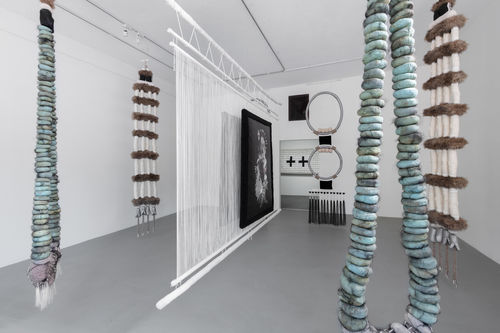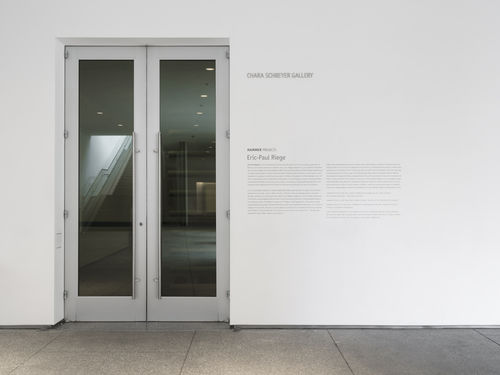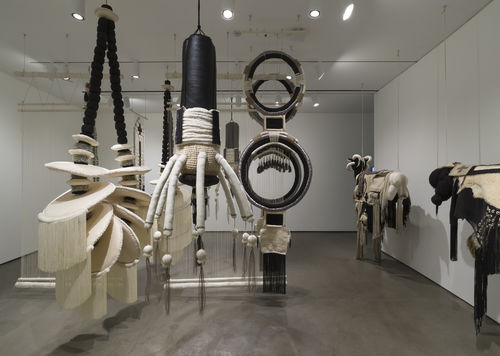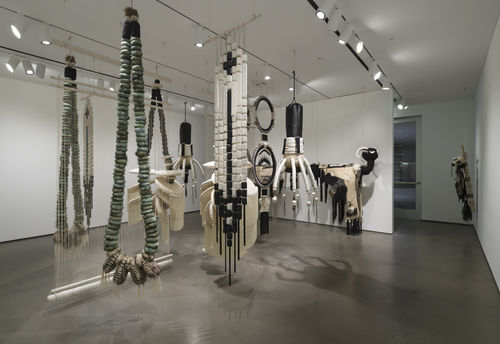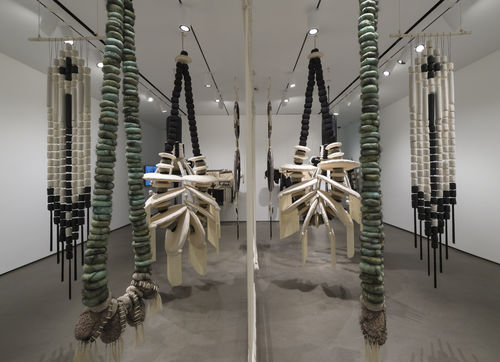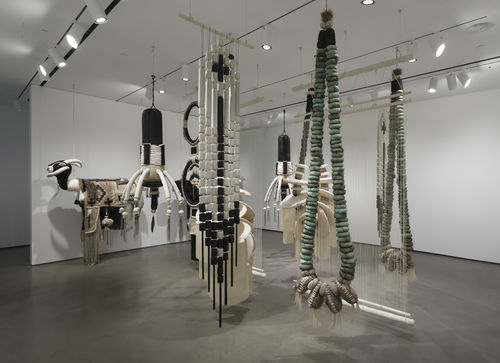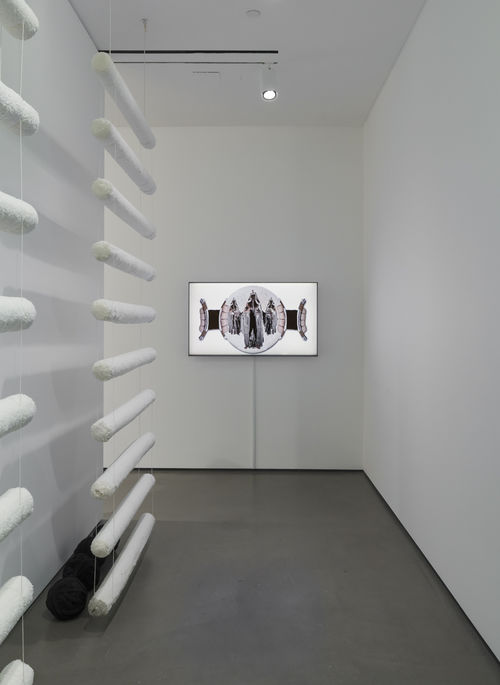
Hammer Projects: Eric-Paul Riege
Eric-Paul Riege (b. 1994, Na’nízhoozhí [Gallup, New Mexico]) uses a rich array of natural and synthetic materials—including wool, cotton, shells, faux fur, and human hair—to create his signature woven sculptures that reflect on the Diné (Navajo) philosophy of hózhó. Hózhó, as a practice in everyday life as well as in Riege’s own artistic practice, is a worldview which encompasses the values of beauty, balance, and goodness in all things physical and spiritual. For the artist, hózhó lives in the continuation of the Indigenous weaving and jewelry-making traditions inherited within his own family history, particularly from his maternal ancestors. Often displaying these intricate objects as suspended looms, and activating them through video and performance, Riege uses space, sound, and gravity like any other material manipulated by the artistic hand. What results are sensorial installations built in homage to cosmology, craft, and inherited knowledge, where the spiritual and physical realms of memory are bridged as one.
For his Hammer Project, Hólǫ́llUllUHIbI [duet], Riege presents a new series of sculptures visualized both as swaying trees and pieces of ornate jewelry, or what the artist calls “totems of memory”—personal objects which assist in the holding of psychic energy as one navigates the world. The works employ a mix of new and recycled fiber from previous artworks, reflecting the artist’s celebration of a material’s ability to “sing so many new songs.” In their scale, the hanging sculptures—likened to living spirits—also recall the period of Diné creation myth during which giant gods (“big monsters”) roamed the earth before the birth of humankind.
Premiering additional new works in video and sound, as well as a series of opening performances to coincide with the exhibition’s opening, Riege cultivates a forest of memories entwining the many-layered “threads of weaving and life.”
Hammer Projects: Eric-Paul Riege is organized by Connie Butler, chief curator, with Vanessa Arizmendi, curatorial associate.
Essay
By Connie Butler
Eric-Paul Riege is part of an emerging generation of Native artists whose work flaunts tradition yet is deeply steeped in it. Caring little for the either the restrictive categories of the traditional crafts or the seductive vastness of international contemporary art, Riege instead forges a practice that mines both. Combining sculpture, installation, video, and performance, he describes his work as a belief system, a mapping of a worldview, elaborated through his hands and channeled through his body. Exhibitions and projects are initiated by durational performances in which Riege appears fully cloaked in the regalia of his sculptural materials, his skin dusted with beautiful striations of charcoal. As if dipped in the dry earth, his lithe body weaves and nods among an undulating landscape of gently swaying soft sculptures. Each iteration of a sculpture or enactment of a performance is connected to the Diné or Navajo people, the Charcoal Streaked Division of the Red Running into the Water People.1 Riege also maintains a deep ambition for his work to connect with his audience. Using his body as a medium through which to communicate the wisdom and poetry of his ancestors, he weaves a living, breathing present tense for his large-scale sculptural forms, which hang from the ceiling and inhabit the space of the gallery.
The weavings, hanging abstract forms, and pendulous stuffed animals that are all worn or activated during the artist’s performances are not immediately recognizable to non-Native viewers as enlarged earrings, necklaces, and body adornment. As if waiting to cloak the body of a larger-than-life figure of the imagination, these handcrafted sculptural forms are also humorous and evocative of pop art’s potent mix of scale and critique. Riege is the son of a Navajo mother and a white father from Ohio, and the duality of his identity is always present in his work and underscored by the parallel existence of Native residents and non-Native tourists in his hometown of Gallup, New Mexico: “I grew up in Gallup, where there’s a dichotomy of traditional craft and lifestyles versus the downtown area that is all run by non-Native shop owners. So there’s this dual idea of identity, and being half-white and half-Navajo—that’s what I’ve dealt with.”2 Riege’s Diné or Navajo heritage means, in part, that he comes from generations of weavers and deploys techniques that he learned from his great-grandmother, grandmother, and mother, all powerful women.
The gendered nature of this transference of women’s labor to a young queer boy of mixed heritage contributes to Riege’s sense of both honor and irreverence—the ways in which he inhabits a daily reality of both deep history and contemporary ambivalence. It exists in something as simple as his choice of materials, which include the cotton, wool, and natural fibers cultivated and used in traditional weaving as well as the synthetic yarn and fabrics trafficked in the tourist objects that are also part of his reality. All of these exist simultaneously in his hanging sculptures that reference weaving in particular. Sheets of plastic, for example, can appear, held taut between cotton strings that mimic the look and materials of a loom. Riege works at home, and the process and apparatus of weaving are part of his daily life. Some of the most delicate of his hanging works seem to embody this porousness, the fragile tension of everyday activities that generate poetic and complex works of art. Being on a video call with the artist during the last months of COVID-19 lockdown was a little like watching a magic show performed in his living room. Animated and talking quickly and excitedly about new ideas and materials, Riege pulled out sculptures and materials as if conjuring them on the spot. For him weaving is as much an actual, physical process that undergirds his work as it is a metaphor for how his art practice exists within his life and identity. “My memory is woven into so much around me,” he says, the lineage of fiber “woven into my blood.”3 The weaving is essential to the work, and yet its undoing is just as profound.
Like that of many of the most visible Native artists who are his contemporaries or immediate predecessors, Riege’s work synthesizes some of the most pointed stereotypes about Native people. Wendy Red Star’s critiques of gender roles in Hollywood’s depictions of Native women, Jeffrey Gibson’s weavings of text and garish color, or Cannupa Hanska Lugar’s work on environmental violence are examples of artwork that exploits the pervasive caricatures of Native people to make the viewer uncomfortable but that also invites a conversation about the possibilities of identity as a way to understand and present the realities of Native life. Similarly there is something of the monstrous in Riege’s performance persona. Equal parts hybrid, cyborg, dancer, poet, and anime creature, Riege, as a performer in his own installations, channels something ancient and undeniably contemporary. In one early performance the artist stood atop a pyramid constructed for a public art event and tossed an object that looks like an overgrown earring or child’s toy into a public square. Part ceremonial gesture, part provocational prank, this spirit of collaboration with the viewer is typical of his work. He lurks among the viewers, self-conscious about his intrusion into their space but also in a world of his own. The viewer can take it or leave the artist to his own hovering, swaying, moody devices. Riege always obscures his own identity by covering his face with a mask or other material. Often his body is so heavily cloaked with material that only his feet are visible and audible because of the shells that mark the soft swaying and gentle stomping of his public, private rituals. The lack of eye contact preserves his inner focus while performing durational works and also speaks to something pointed about resistance and refusal. He desires to be among us but not to be consumed.
Riege’s identity is fluid not only in his sampling of craft and the past of his matriarchal ancestors but also in terms of the future and how he imagines carrying forward the gift of his work. In 2019, as part of a final performance for the SITE Santa Fe Biennial, Riege “birthed” a child figure, an inheritor of past and future as well as a collaborator on subsequent projects. Holq is made of cloth and other materials characteristic of Riege’s work, and the artist keeps him close to his body during the performances in which he is included. About this progeny the artist says, “As Holq exists, he does so alongside his ancestors and his children. This exhibition [SITE Santa Fe] was a space for Holq to listen and watch. Acting as a baby’s mobile of sorts, the works surrounded Holq and wistfully swung around and through him. They whispered and sung to Holq.”4 Holq is some ways a doppelgänger for the artist, a stand-in for his own identity, which is always in formation. The surrogate child, also a collaborator and present in the Hammer installation, functions to transform Riege into a nurturing, life-supporting being. “Central to Navajo philosophy is the idea of change, transformation and renewal,” according to Janet Catherine Berlo and Ruth B. Phillips, whose Native North American Art is a primer on Native cultural traditions. “The universe itself was woven on an enormous loom by the mythic female ancestor, Spider Woman, out of the sacred materials of the cosmos. Spider Woman taught Changing Woman, one of the most important Navajo supernaturals, how to weave. Changing Woman provides the model for the Navajo aesthetic of transformation.”5 Also embedded in the meaning of Navajo textiles is that change has value greater than the finished product. Riege is constantly reworking his sculptures, and older works get repurposed for current installations. Holq is always and constantly being brought anew to the space of the work.
Digital video and drawing have become mediums well suited to Riege’s cultivation of transformation and change within his work. He uses simple devices of mirroring, doubling, and morphing to create image collages that are striking in their formal order and also in their infinite mutability. Text-based drawings and poems provide the artist a way of thinking through ideas. Words and letters that are digitally manipulated and typographically warped and woven into anthropomorphized shapes that undulate and float on-screen carry the erotic charge of a love poem or the hypnotic rhythms of an incantation. Riege treats these like a storyboard for working out ideas and images for a show or a body of work. He also treats performance stills in a similar manner, doubling, repeating, and layering images of himself in costume to create gorgeous, totemic forms based on his own body but nearly unrecognizable as him. Within the poetry of his text based notes and drawings is the phrase, My Body is a Drum. Indeed it is through his work that present and past histories are woven.
Notes
1. Riege’s description of his own family lineage is from his unpublished thesis, “DiBE Hozhq Yitlo” (BFA thesis, University of New Mexico, Albuquerque, May 2017).
2. Eric-Paul Riege: Hóló—it xistz (Miami: Institute of Contemporary Art, 2019), https://icamiami.org/video/eric-paul-riege-the-gifts-youve-been-given/.
3. Eric-Paul Riege, 14.
4. Eric-Paul Riege, correspondence with the author, fall 2022.
5. Janet Catherine Berlo and Ruth B. Phillips, Native North American Art (Oxford: Oxford University Press, 1998), 65, 67.



